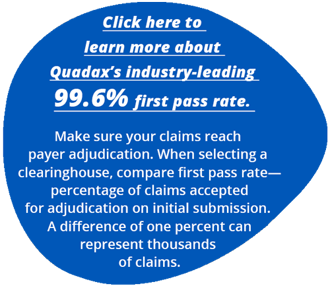A cost-effective claims follow-up strategy can help maximize your reimbursement and improve your revenue results.
Ideally, claim follow-up should only be performed by your staff when taking action defends the reimbursement you deserve. Any action taken that does not directly improve your reimbursement or cash flow, erodes your profit margin by increasing costs without increasing revenue. One way to control follow-up costs is to use advance claim status to identify when claim follow-up makes “cents.”
The key is to know which claims would best benefit from follow-up.
It all begins with knowing where your claims are in your payers’ review process – assuming your claims made it to the payers’ review process.
Looking at the key stages of the payer’s review process, let’s identify when follow-up makes "cents" and when it doesn’t.
- When the claim status is in-process, no follow-up action is recommended. The payer has not yet made a decision on the claim. At this time, it may be more cost-effective to wait. After a certain amount of time has elapsed, a second claim status inquiry can be made.
- When the claim status is to-be-paid, no follow-up action is required. The payer has made a decision to pay the claim and a payment will be received. Any action taken by staff adds cost to confirmed reimbursement. Gaining insight that a claim is to-be-paid at the time of the payer’s internal decision (which may be much sooner than upon receipt of remittance advice), can help your staff avoid unnecessary follow-up.
- When the claim (or line item) is denied, rejected, or pending, it is important the right follow-up action be performed in a timely, efficient manner. To identify the best course of action, it is critical to fully understand why the claim (or line item) has not been paid. Follow-up staff can target next steps and avoid the cost of trial-and-error issue management.
So how do you obtain claim status information? Labor intensive options include calling the payer or accessing the payer portal. Both options are high-cost, low-volume solutions that require manual processing. It is more cost effective to obtain your claim status responses electronically. According to a 2016 study by the CAQH Index,® switching to an electronic process for claim status inquiry can save up to $7.94 on the cost per transaction over manual processing representing an 81% savings. Though automated ANSI 276/277 claim status inquiries and responses provide some benefit, the problem is that payer ANSI responses tend to lack the more actionable data found in payer portals. It is generally the detailed proprietary payer codes and comments found in payer portals that offer the best source of information.
Here’s where Advanced Claim Status (ACS) by Quadax can help. Electronically scraping status information directly from payer portals using web-bot technology, ACS replaces or supplements standard ANSI 276/277 transactions to provide richer, more actionable information. Reporting claim status and denials as soon as one-day post billing, ACS provides electronic access to payer proprietary remark codes and descriptions allowing you to understand why a claim is pending or rejected and to know it sooner. Using more comprehensive information to enable “workflow by exception” processes, ACS avoids the cost of unnecessary follow-up and frees your staff to pursue follow-up on the claims that would best benefit from further intervention.
When managed cost-effectively, and fueled with the right information, your claims follow-up strategy can help maximize your reimbursement and improve your revenue results. For follow-up made easy, learn more about our Advanced Claim Status (ACS) solution.


